#yoof magazine
Photo





yoof magazine (1996), courtesy of the y2k aesthetic institute
#yoof magazine#scan#y2k#y2k style#y2k aesthetic#webcore#old web#cybercore#internetcore#archive#art archive#magazine#magazine scan#fashion#futurism#futuristic#aesthetic#aes#inspo
9K notes
·
View notes
Photo


Yoof Magazine - Vol. 34 - Summer 1996 By Rony Platenkamp & Roland Arnassalon of M A Deymann
#retrogaming#y2k aesthetic#jet set radio#space channel 5#comics#queer art#gameboy#playstation#pc setup
79 notes
·
View notes
Text




yoof magazine (1996), courtesy of the y2k aesthetic institute
7 notes
·
View notes
Note
If someone were trying to make a new character inspired by pulp heroes, but the new character had to be a teenager, what existing pulps heroes should they look to for inspiration?
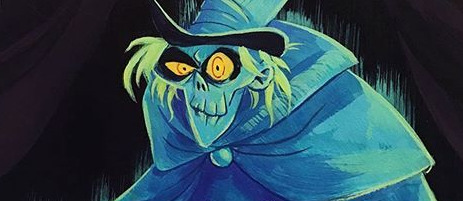
I'm not exactly in touch with the yoof so I could be off the mark here, but let's talk about teenager characters for a bit.
Now, I could just tell you to look for characters that appeal to you and use them as a baseline and that's probably the best advice here, but if you want the essay and history lesson: American pulp fiction didn't used to market much to teenagers. Teenagers as a consuming market haven't always been the all-encompassing force they are considered today, and the pulps were largely marketed either towards young boys, or for working class men, mostly the latter. This is part of why teenagers tend to show up in these stories largely as sidekicks, which was something carried over to comic superheroes, and part of why Spider-Man was such a breakout hit, because he was a teenage superhero who was not a sidekick.

The biggest pre-1950s traditional pulp hero I can of who was a teenager would be Jack Harkaway, an 1871 penny dreadful adventurer who would go on to be published overseas, one of those characters who was big enough in his day to inspire imitators a plenty but didn't quite make it past a specific time period. Comic strips had plenty of kid or teenage protagonists who are a bit closer to pulp heroes, like Tintin or Terry Lee, one in particular I'm highlighting above is Ledger Syndicate's Connie Kurridge, arguably the first female adventure hero of American comics. Overseas you can find a couple of prominent examples of teenage adventurers published in what we call the pulp era, the biggest and most influential of which being The Famous Five, but as I stated in answering whether Nancy Drew or the Hardy Boys were pulp heroes, these were not published in pulp magazines, instead their direct opposites in glossy and reputable paperbacks.
There are other examples of pulp heroes who were teenagers and not sidekicks, but nearly all of them are very obscure and you will probably not find much material for them. And the thing is, these characters were not made for teenagers. They were made, for the most part, by grown-ups, and for grown-ups, and I can't say any of them ever really grabbed a teenage audience. Usually, it's the 60s as an era that really starts to pander to and include teenagers at the forefront of storytelling, so a good start for you might be to look at what was going on in the 60s-onwards worldwide in the realms of pulp and pulp-inspired works, which probably means you're going to have to look outside of the US.
Another word of advice would be to look up characters that are beloved by teenagers. I don't think "teenager" is a great baseline trait to start building a character, but if that's the number one priority to you, then ideally you should look for a good baseline of what appeals to that demographic, what appealed to you at that age and why. You're probably going to wind up with a lot of anime anti-heroes in your research though, because teenagers are deeply miserable creatures and few things appeal more to them than characters who are miserable but they act cool and badass and edgy about it. Teenagers are forced to live with the miserable reality of being teenagers with little to no upsides, so I think teenage characters could benefit more from being based on the kinds of characters teenagers would ideally want to read about.
So, "cool, badass and tortured character super popular with angsty teenagers", "rooted in and subverting older storytelling traditions for a fresh new audience", and "60s pulp hero". I think Elric is probably as good of a place as any for you to start.

Elric wasn't just popular, he wasn't even just popular with teenagers (boys and girls alike, which is also quite the feat), he was "cool". He was avant-garde, he was the hip new thing on the block. He wasn't Conan or Bond or Batman, and you'd hardly mistake him for a hero. He got the rock albums and fans tattooing him. He was penned by the guy who was openly called the "anti-Tolkien". Elric was Loki before Loki, the edgy anti-hero before them all. The emaciated warrior with white hair and black clothes and a demonic sword who suffered in a cool way, cool in his uncoolness. When I think of pulp heroes who achieved a substantial popularity among teenage audiences, Elric is definitely the first that comes to mind.

Another good example might be Captain Harlock, easily one of the premier Pulp Heroes among manga and anime due to how heavily Leiji Matsumoto incorporates pulp space opera into everything he does. Not only directly influenced by it, Matsumoto even has actual pulp credentials as an illustrator for C.L Moore's Shambleau, Northwest Smith and Jirel of Joiry. The space pirate, while not created in manga and anime, is one of Japan's premier pulp hero archetypes, and Harlock's as good of a baseline to work with as any.

The most popular pulp-inspired works nowadays among teenage or younger audiences are definitely the ones derived from pulp horror, several creators have been getting a lot of mileage these past decades out of plundering and remixing stuff from it. The big ones are Lovecraft and related works like The King in Yellow, but because they soak up all the attention, it also means that people are sleeping on authors like John W. Campbell, William Hope Hogdson, Clark Ashton Smith and Karl Edward Wagner, Nictzin Dyalhis and Olaf Stapledon, and many, many more, which gives you a lot of narrative real estate to work with should you take this direction.
Additionally, one thing that you could consider is that, for a very large portion of the history of pulp fiction, a significant amount of the most popular stories and characters were those that were based on celebrities and real life figures. The biggest of dime novel protagonists was Buffalo Bill, and following him was Nick Carter, a literary equivalent to Eugen Sandow (the Schwarzenegger of his day). Thomas Edison inspired an entire subgenre of dime novel fiction, even Jack the Ripper was a pulp protagonist in Dutch magazines, because sometimes the term "pulp hero" doesn't take the "hero" part much into account.
The precedent for celebrity stories is older than pulp fiction itself, but it was in the dime novels and novelettes and pulps that the idea really found it's footing. The Shadow's exploits took a lot from Gibson's own experiences with Houdini (who himself starred in fictional stories, one famously penned by Lovecraft). Doc Savage was visually modeled after Clark Gable and supposedly inspired on Richard Henry Savage. Eddy Polo, Charlie Chaplin and Tom Mix were the protagonists of several pulps and comic strips across the world, as well as Al Capone (who starred in pulp magazines in Germany and Spain), who fought Nick Carter in a Brazilian story guest-starring Fu Manchu (reportedly based on real figures Sax Rohmer claimed to have met) and Fantomas. Today obviously there are much greater restrictions at play concerning celebrity images, but if dime/pulp magazines were around today, we would have quite possibly seen figures like Keanu Reeves, Tilda Swinton and Lil Nas X either star in their own magazines or be used as models for rising protagonists.
So I guess one other way you could go on about creating a pulp hero, who's either a teenager or appeals to teenagers, would be the route of taking a look at some celebrities that either are, or appeal to those demographics, because if pulp magazines had stayed around unchanged past the 60s and 80s and whatnot you definitely would have seen the likes of David Bowie, Will Smith and Dwayne Johnson get their own magazines. I don't know much about what celebrities are popular with teenagers these days and I'm not about to start caring now, but you could take a look at some icons you like, or liked when you were younger, and think about what made them appealing to think about as characters, and how you could apply that to something closer to a pulp story.
A word of advice would also be that, if you want to make a character inspired by pulp heroes, if you want to create a convincing modern pulp hero, you might want to look less at the pulp heroes themselves and instead those that they were inspired by or working to defy and stand out when compared to. You take the building blocks and rearrange them in a different way. If you have a specific character you want to design yours in reference to, you can send me an ask or a DM about them and I'll dig into my files to give you a few pointers, and what kind of history or cultural predecessors they have that you could take a look at to make something more genuine.
#replies tag#pulp heroes#pulp fiction#jack harkaway#captain harlock#elric of melnibone#bloodborne#darkest dungeon
100 notes
·
View notes
Text
I’ve spent the course of COVID lockdown cycling through hyperfixations while also trying to engage in some much needed therapy (lolsob), and I’ve been essentially encouraging myself to try and do more things I can enjoy without feeling shame. Anyway, that’s a short way of saying I decided to blog about all the music videos of Depeche Mode for reasons of science.
The science is that my basic premise is that most of the videos are pretty bad in ways that I find to be pretty strange. Full disclosure is that I spent my teen years being a huge Cure fan and there’s an overlap there? Of songs with very niche high-concept ideas that don’t necessarily map onto a model of popular music but found mainstream success in the rise of new wave music in the wake of the collapse of first wave punk and amplified by the creation of music videos and music video TV. And I owned all the Cure music videos and played them on my iPod Nano because I was a very strange child. But to get back to my central thesis, many of The Cure’s videos are very stylised and fun and memorable in ways that are good. And yet, despite existing in the same sphere and having an overlap of fans, the music videos for Depeche Mode mostly stay bad until the end of the eighties, a fact I will prove by watching them all.
Can you tell that I am bored because i have lost my job and my mental health is making me fixate on strange shit currently because that is absolutely the case right now
Speak & Spell
Dreaming of Me (Feb 1981)
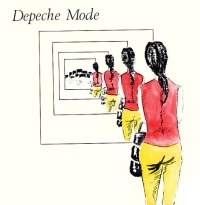
The single art is really lovely - the red/yellow contrast is very striking against the white, and I really love the design. Hey remember when people used to go out and buy singles and you would appreciate them and the work that went into them? I don’t think I’ve bought a physical single since I was about sixteen. I used to buy them from the Woolworths music department because it was cheap and all my friends worked there, so they had a pretty lenient attitude about what exactly constituted paying for things. Woolworths policy of only hiring teenagers is probably what destroyed their business.
Anyway, Dreaming of Me did not chart super well, getting to number 57 and having no official music video - or actually getting onto the album. It wasn’t included on Speak & Spell in the UK until the 2006 re-release. So, there was no music video for me to look at…
Apart from this video I found from local TV in 1981 to promote the song. It’s a maybe-music video. Because music videos had only been around for about six years and MTV didn’t exist until later in the same year, my guess is that Mute Records were pretty cautious about putting money into a medium that might cost more than they would get in publicity. That’s only a guess. I don’t have a crystal ball for forty years ago.
Anyway, here are some children recording music.

If i was 19 and someone offered me a recording contract I would have taken it without thinking (like i took on all those student loans without thinking through any consequences wompwomp) but now I am nearly thirty I watch this and think, ‘These children shouldn’t be outside unaccompanied’. The passage of time has made a fool of me.

They go bowling and play Space Invaders which, hey, still sounds like a great night out to me, but I’m guessing that because this is very clearly aimed at teenagers the TV producers didn’t want to encourage teen drinking by showing them performing a gig at a club night.
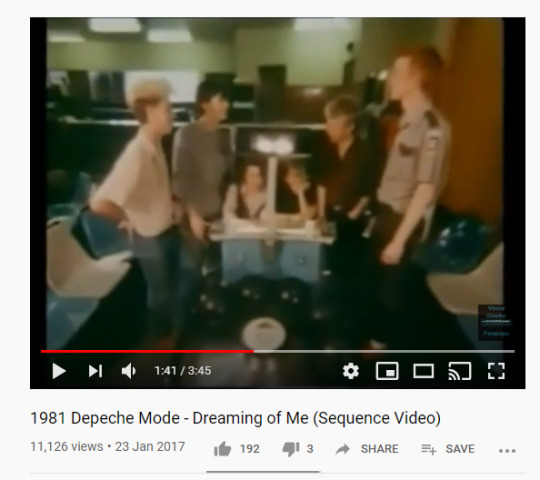
I call it high fashion. The all-grey really sells it.

This reminds me so much of a advice column in teen magazines - when they’d have problems set out in a little faux-comic strip of still photos? ‘My best friend stole and read my diary’ ‘My crush found out about how I feel and now he’s going out with my best friend’, that sort of thing. That is also a classic carpet pattern. I think my grandma’s living room had that carpet.
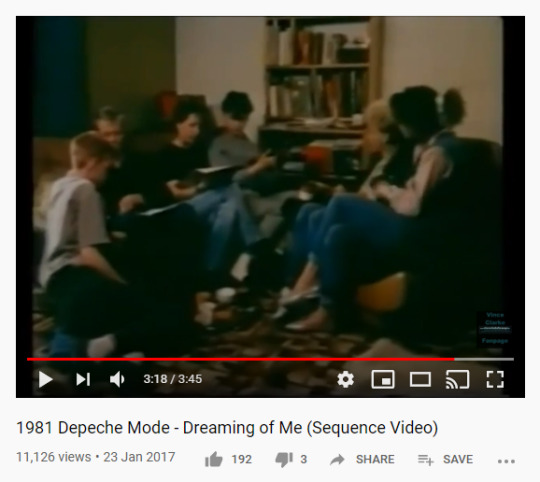
The video is very naive! It’s the sort of thing we would all see now on Youtube from bands just starting out and it is wild to me that this went out on TV. It’s very un-glossy and normal, the stuff that bands put out on YouTube now because of DIYness.
New Life (June 1981)

This is also a really great piece of single art. It’s very bold and striking - it would definitely be the standout record in a sea of other 7’’ released the same week. It also doesn’t particularly match the tone of the single but eh, it looks pretty cool. New Life did much better than Dreaming of Me and got up to number 11 in the UK singles chart. Still no official music video, but the charting meant that the band got onto Top of The Pops! ToTP was cancelled when I was a wee baby teen, because the BBC decided to stop caring about yoof viewership and promoting music was circling the drain everywhere as streaming hit, but it was the place to promote music so was definitely a sign that You Had Made It.

So, last video was silly and made by children, but now they’re wearing see-through mesh shirts, leather trousers, and leather hats with a design that I am a little bit dubious about. I grew up on the oi/punk scene and let me tell you about how many first wave punks wear iconography of bad regimes for faux edginess reasons because I met a LOT of them in my time.

Oh boy do i have thoughts about that hat. It also looks like a Leather Daddy hat which, well, let’s leave that thought to one side. Most ToTP performances were lipsynced. Playing things live would sound weird in the studio, be picked up strangely by the audio equipment and the cameras, so 99% of performances were mimed to the single. Now, some acts would deliberately play up to the pretence and refuse to act like they were doing anything that corresponded to the song - The Jam, The Communards, and The Cure are literally the first examples that come to mind who would just… not do anything close to pretending it was real.
This is not that. It is very earnest and awkward and serious, which sort of makes it very sweet.
Just Can’t Get Enough (September 1981)

Right, that is shibari, isn’t it? I’m not blind, am I? It’s a very striking image that 99.9% of people would not recognise other than being a striking black and white image.
I don’t think I can overstate how… innocent, in a way, this point of time was? As in the general level of knowledge about non-conventional stuff in the wider public at large. As in my mother, an almost teen at this point, saw George Michael walking with his boyfriend in central London and had no idea he was gay until he came out. It’s actually the widest cultural gulf I can think of between her teen years and my teen years because I was very aware of queer people from a young age.
Anyway, moving on, I feel like it bears repeating that this song fucking slaps. It’s the last single to be written by Vince Clarke and the last single until 2006 to be written by someone other than Martin Gore. This is one of those songs that just works on every level. Can you imagine coming up with this for the first album of your band? That blows my mind. It’s so overpoweringly good that it was probably for the best that it was saved for last - coming out the gate with a guaranteed fucking banger was been the nail in the coffin for a lot of other eighties synth/electronica bands. They scored a huge hit and then nothing after that managed to be as good or meet the hype. Depeche Mode had built up a far bit of radio play and interest before dropping this which turned out to be very good in the long run!
This got to number 8 on the UK charts and the first to get a music video! It is the only one with Vince Clarke. Full disclosure in that I had this song on my iPod through downloading the video to my computer (that’s how we got songs without using stuff that would give us viruses because i got a ton using bearshare for rare cure demos) and I remember watching the video, all of sixteen years old, and thinking, ‘Man, all these people look so grown up, compared to me, I can’t wait to be an adult!’.
Twelve years have changed my view, somewhat.

Look at this little baby man. Were you in one of my A Level classes - as in, ones that I have taught, not ones that I have been in.
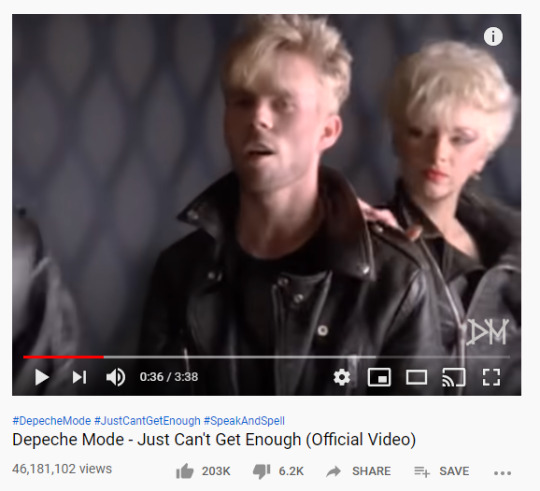
Vince Clarke, however, has had a significant glow up in the six months and now looks like he is the bouncer in a leather bar. This is the One Adult in the room.
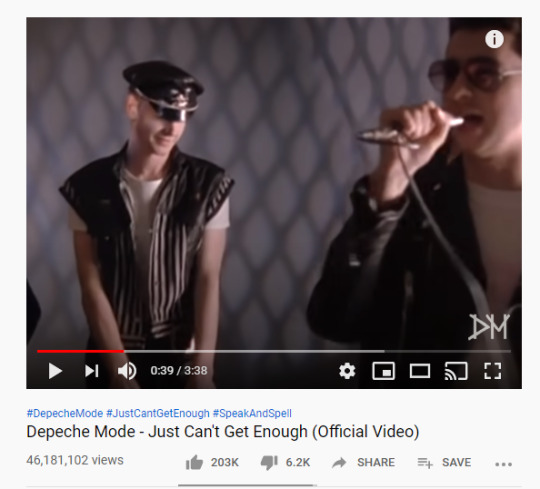
Ahh, I see it’s Open Mic Night at the local leather bar. You know what I was saying about how teens in the eighties tended to be significantly more naive about what we might call certain signifiers? Because what this outfit says to me, a queer woman in 2020, is susbstanitally different than to my mum and her friends watching this when it first came out. She would read this as ‘This is totally rebellious and cool!’ while I go ‘Someone just joined the university kink club and spent all their bursary’.
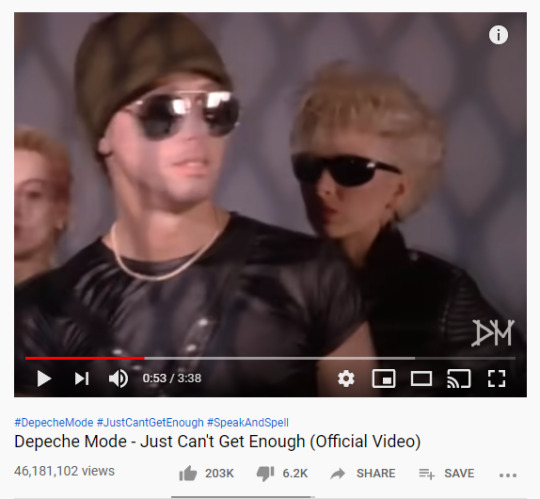
I don’t remember the member of Blazin’ Squad that wore a slave harness. (Now, there’s a reference that shows my age. A Blazin’ Squad reference in the year of Our Lord 2020. Hoooo boy.)

I read somewhere (that I can’t find now because, of course I can’t) that these are the band’s girlfriends and I always remembered that because it made me think, lol, same. One of my closest friends is the Head of London, so she’s in every band in London and if she’s not in yours yet give her time, and my partner was in a locally successful metal/hardcore band for about a decade and being connected with any sort of band means you will be helping out hugely behind the scene constantly. I have held lights, moved speakers, picked up instruments, been in music videos, and have bought tearaway trousers and glowsticks for gigs. You get called in to help all the time which is a lot of fun, so that fact always just stuck with me. It also makes sense financially because then you don’t have to hire any professional backing dancers, you can rely on people who will happily do it for free (while looking pretty rad while doing it!).
Anyway, the band look like those generic raiders that you run into when randomly walking across the map in a Fallout game.
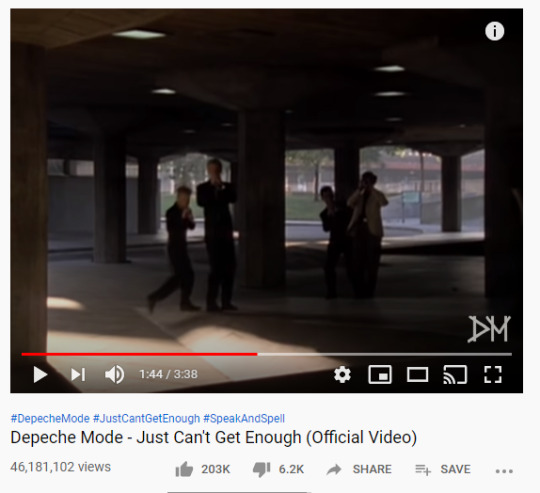
I love awkward choreography in music videos. It feeds me.
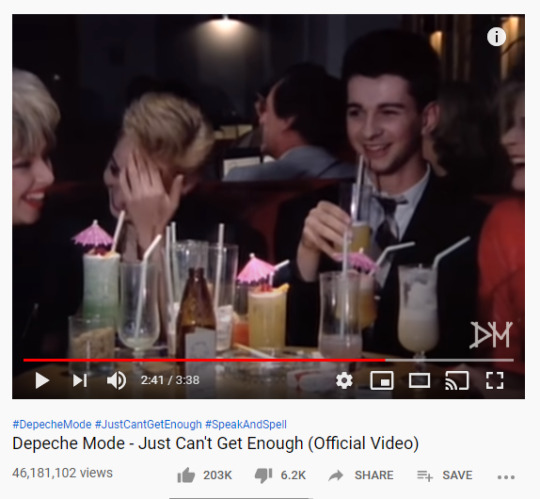
Filming a night out provides A) Great footage and B) Can be done for limited overheads, leaving more money to be put into promotion.
I always like seeing this sort of footage in music videos. I tend to see a lot of it, given the DIY punk scene, and it always charms me. I am easy to please. And all those women have the most amazing eye makeup that makes me super jealous because it all looks so good.

That hat is on point. This looks like a still image for some sort of cyberpunk big band style swing revival that, sadly, lives only in my dreams.

It took me so goddamn long to screenshot this shot probably because i was also blasting dream nails whoops
Anyway those are my reactions to Speak & Spell’s one solitary music video with some other things thrown in and this took me way too long. I make myself laugh though, that’s the main thing. I will do A Broken Frame… at some point. I think I have a bunch of vinyl for A Broken Frame? My mum actually bought all the singles for that album and I stole most of her collection years ago. I will have to search and see what I can find.
3 notes
·
View notes
Text
Long(?) post about not understanding what makes literature important. Nothing new in it. Just rambling.
Occasionally I remember and am amused by the fact that a random literary magazine has mild cancellation-dirt on me because one class required us to submit Something and the Something contained Problems. This post is about different Problems.
Fools that they are, they said “any genre is fine” and opened themselves up to rabble writing about space bullshit for bad reasons such as “space bullshit is fun” rather than enlightened reasons such as “space bullshit can be a metaphor for mundane bullshit.”
Which isn’t wrong exactly. Outer Wilds (which I evidently cannot shut up about despite never having played it and it being old news at this point) is transparently about coming to terms with mortality and quite frankly you’d have to be very dense to deny that. But it’s also about archaeologizing mysterious space goats. Any inept dumbass can run up to you and shout “ya gonna die lol.“ The “meaningful” meaning only has any weight because it’s fully integrated with the world you’ve been exploring for such un-literary reasons as “because it’s cool” and “because I want to know what happened here.”
I legitimately do not understand the point of literary fiction. “Oh it communicates Meaning(tm)!” Write out the meaning then. Save everyone the time by not encoding it in a boring story. Or encode it in an interesting story.
“Oh the story doesn’t matter! It’s really about pretty words!“
I see this one a lot and frankly it doesn’t even make sense. “Combine words to sound pretty” does not directly lead to “countless stories about nothing happening all written in the same dreary voice.” You are skipping several steps in your reasoning there. There is nothing stopping you from writing pretty words about wizards, or pretty words that do not form a coherent narrative, or pretty words arranged purely based on sound that cannot even be interpreted as sentences.
...I’m going to regret making this analogy, but by way of illustration, there was a post on stupidpol many months ago that stuck with me where someone thought it would be a good idea to have universal military service specifically for the harsh regimentation of presentation, to disabuse Da Yoof of their shallow bourgeois individualist hair dye etc. so they can focus on the REAL things that set them apart as individuals (would not elaborate).
There was thankfully pushback to this nonsense and a bunch of asking for an explanation of what is real and fake individuality and all the person could say was “if you don’t intuitively know what it means I can’t explain it adequately with words, and you’re the one that’s doing this dogmatically and unthinkingly, somehow“ and while the literature thing is less egregious it strikes me as similar in shape? “Thing that brings you joy must be removed and replaced with thing you dislike. I will not posit a reason for this but will treat you as morally and intellectually deficient if you ask for one.”
It is, fair cop, the same thing as me saying “humans must not be muscular because you can directly observe how disgusting they are and everyone that disagrees has taste disease.“ (The difference is that I am right, unlike the others who merely falsely assert that the difference is that they are right.)
There are explanations, in the case of literature, but they’re nothing explanations. The counterarguments are trivially easy to notice. I don’t know why these are conversation enders. They are not atomic! There are rebuttals! It’s always “ah, I understand the importance of saying things everyone already knows“ ????????
Like, if the goal is for everyone to have “good taste”
And good writing Says Something Important About Human Nature
This means the list of Important Things About Human Nature is known, and probably written down somewhere, in order to standardize taste to it.
Which calls into question why it’s important for writing to Say Something Important because the Something Important has already been said and is universally known, and if we’ve established that writing that doesn’t Say Something Important is mindless trash, the story in not necessary. Because the important thing exists separately, and if you remove the important thing from the story the story is just mindless trash, so you’re just putting the important thing in a container you admit is worthless and saying that’s better?
I’m incredibly confused.
1 note
·
View note
Text
Katie Puckrik is doing a guest spot on 6 Music and I've fallen down a hole of 90s nostalgia about The Sunday Show, and yoof magazine shows in general...
1 note
·
View note
Text
Nazis & Church of England Bastardize Baptism to play Identity Politics
As flies to wanton boys, so is liturgy to the Church of England. For the last three decades, liturgical fidgets have been monkeying around with the sacraments for their innovative sport of inclusion—our yuppies and “yoof” speak gangsta rap and not Elizabethan English, they argue, so let’s make our services inclusive!
Committees of liturgical busybodies paddling in shallow pools of pragmatism and therapy have dumbed down the Book of Common Prayer’s sonorous and sublime services to milksop, PC prayers, which sound as if they were written by a quango composed of Shami Chakrabarti, Alexandra Ocasio Cortez, and Noddy.
(function(w,d,s,i){w.ldAdInit=w.ldAdInit||[];w.ldAdInit.push({slot:10817585113717094,size:[0, 0],id:"ld-7788-6480"});if(!d.getElementById(i)){var j=d.createElement(s),p=d.getElementsByTagName(s)[0];j.async=true;j.src="//cdn2.lockerdomecdn.com/_js/ajs.js";j.id=i;p.parentNode.insertBefore(j,p);}})(window,document,"script","ld-ajs");
Anglicans can live with this pulverized puerile pap. It’s not the unpardonable sin. But the Church of England’s liturgical meddlers have not stopped at watering down the sacramental gruel. Like the Witch of Endor summoning the ghost of Samuel, the House of Bishops have invited the Frankenstein of identity politics to preside over a new subversion of the sacraments.
First, they hijacked Holy Orders, a diabolically dextrous move, since ordination is not a sacrament for evangelicals and charismatics in the CofE. Only Anglo-Catholics and conservative evangelicals objected (for different reasons) and were checkmated by the feminists in Synodical War I for Women in Dog Collars and the Synodical War II for Women in Pointed Hats and Purple Blouses.
Next, they came for Holy Communion, inviting people persisting in pansexual sin to the Table of the Lord, using florid euphemisms like “Open Table” and “bigger Table.” St Paul’s teaching on a “closed” table “open” only to repentant sinners—a mandate steeped in Holy Scripture (1 Corinthians 11:27ff), the Catechumenate, Eastern Orthodoxy, the Book of Common Prayer and non-conformist churches from Baptist to Brethren, was trashed in the compactor of gay identity politics.
Now, like the Three Witches from Macbeth, they are wrapping their bony fingers around the Church’s jugular—the sacrament of baptism—and chanting their Shakespearean chorus of “Fair is foul, and foul is fair/Hover through the fog and filthy air.” If they can capture baptism, they’ve won the goostepathon of identity politics. Why? Because baptism is the sacrament of identity.
Martin Luther, when fighting off bouts of depression, was heard to shout, “I have been baptized!” Luther was declaring his new identity, as a new person, under the dominion of a new Lord, as part of a new body of Christ, and so no longer subject to the old bailiffs of Satan, sin, and death (and depression, in his case).
Jesus’ encounter with Nicodemus calling for a “new birth” by “water and the Spirit” (John 3:5) is about a new identity in Christ through baptism. Paul’s letter to the Romans speaking of baptism as dying and rising with Jesus to new life is about a new identity in Christ through baptism. “For as many of you as were baptized into Christ have put on Christ. There is neither Jew nor Greek, there is neither slave nor free, there is no male and female, for you are all one in Christ Jesus (Gal 3:27-28).
To misappropriate sacramental “identity politics” of baptism, and misapply it to ideological “identity politics” of race or gender is to detonate a dirty bomb at the core of Christianity—dispersing radioactive defilement over two thousand years of the faith and contaminating the church for decades to come.
Guess who were the first to play dirty tricks with the sacraments? The Nazis. They re-wrote liturgy and introduced new understandings of the sacraments. They bastardized baptism and communion to play racial identity politics. Baptism and Eucharist were weaponized to authenticate the biological and ethnic Aryan identity and homogeneity of German blood.
Writes Doris L. Bergen in her research, Twisted Cross: The German Christian Movement in the Third Reich:
“German Christians recognized baptism, the symbol, and proclamation of church membership, as a pivotal point for imposing their racial policy on the Christian community.”
First, Hitler’s definition of Aryan depended on it, or at least on whether your grandparents had been baptized. Under the Third Reich, “every German carried with them a document that had to be on their person at all times. It was not a driver’s license, not a passport, not even proof of citizenship but a record of their racial heritage as attested to by their pastors and their baptismal certificates,” says Steve Martin in the documentary Storm Troopers of Christ: The Jews and Baptism in Nazi Germany.
Without the cooperation of churches, “whose officials recorded baptisms, issued baptismal certificates, and provided proof that relatives and ancestors had been baptized, it would have been impossible to enforce any distinction between Aryan and non-Aryan Germans,” observes Bergen. She writes about a German Christian who, in 1933, abandoned a “promising career” in a “Jewish bank” to study theology. As a pastor in the Third Reich, he believed he could promote the “two pillars” on which German identity rested: “blood and baptism.”
Second, public statements by German church leaders stressed that baptism could not bring a non-Aryan into the German church. “The baptized Jew does not belong, nor for that matter do the baptized Chinese and Negro,” declared German Christian chronicler Friedrich Wieneke. A signboard in Westphalia summed up the Reich’s theology of baptism: “Baptism may be quite useful, but it does not straighten a nose” (Die Taufe mag ganz nützlich sein, Doch glattet sie kein Nasenbein).
Third, German Christian leaders reinterpreted baptism as a celebration of the unity of blood and an initiation into the community of the Volkbaptized and the worldview of the Führer. Baptism did not bring the infant into a church defined by a confession of faith, a pastor explained, but expressed the community’s “belief in the law of blood and in the race” and the parents’ pledge to “raise this child in German discipline and customs and in positive Christianity.” Hitler used the term in article 24[a] of the 1920 Nazi Party Platform, stating: “the Party represents the standpoint of Positive Christianity.”
Holy Communion was also similarly subverted along the lines of racial identity politics. The elements were reinterpreted, with the bread symbolizing “the body of the earth that, firm and strong, remains true to the German soil,” as one pastor told his church. The wine he called “the blood of the earth,” representing “loyalty unto blood” and total dedication to the *Volk. A pastor in Stuttgart suggested replacing the bread and wine with a communal stew meal on certain Sundays.
Baptism also reminded parents that their children belonged to the German Volk, not to God or to the parents. Lebensborn children, born out of forced sexual liaisons with SS officers, were baptized in an SS ceremony where their adoptive parents swore that the child would have a lifelong allegiance to Nazi beliefs.
Fourth, German liturgists energetically wrote material for new services, edited Bibles, revised hymn-books, altered liturgies, and changed the church calendar. There were proposals for new ceremonies such as a celebration of the solstice that combined songs about comrades, torches, and Germany’s future with readings from Goethe, 1 Corinthians, and German Christian poets.
Bergen draws attention to the “feel-good” and “therapeutic” dimension of these liturgies where theological content and traditional doctrines were replaced by the emotional expression of services. “Worship services” (Gottesdienste) were renamed “divine celebrations” (Gottesfeiern) to highlight this innovation.
(function(w,d,s,i){w.ldAdInit=w.ldAdInit||[];w.ldAdInit.push({slot:10817587730962790,size:[0, 0],id:"ld-5979-7226"});if(!d.getElementById(i)){var j=d.createElement(s),p=d.getElementsByTagName(s)[0];j.async=true;j.src="//cdn2.lockerdomecdn.com/_js/ajs.js";j.id=i;p.parentNode.insertBefore(j,p);}})(window,document,"script","ld-ajs");
A principal aim of these liturgies was the creation of the new identity of Gemeinschaft (community) among the Volk. “The fact that Nazis were able to recycle already-existing aspects of church services in the service of their ideology should disturb us all,” notes Stephen Waldron.
The fact that the House of Bishops is able to recycle the already-existing rite of Affirmation of Baptismal Faith to mark transgender transitioning in the service of the identity politics of gender should disturb us all.
To subvert the central sacrament of Christian identity and to distort beyond description what it means to be live a new life “in Christ” (used over 150 times in the Pauline epistles) is, at worst, to replicate the blasphemous experiment of the Reich church by endorsing a increasingly totalitarian transgender ideology or, at best, to sanctify the mental illness of gender dysphoria or the gender fraud and fiction of “transitioning” from one gender to the other.
Hitler sought to create an impossible symbiosis between the “cross” and the “swastika.” It is not insignificant that “cross” in German is Kreuz, while the German word for “swastika” is Hakenkreuz—a cross with a hook or peg. The bastardization of the rite of baptismal affirmation to affirm gender transitioning is the Church of England’s Hakenkreuz, or, to coin a neologism, Hakentaufe—baptism with a peg—a grotesquely twisted peg on which to hang the ideology of transgenderism.
from Republic Standard | Conservative Thought & Culture Magazine http://bit.ly/2RQPfiq
via IFTTT
0 notes
Text
Do You Operate in a Social Media Bubble? 3 Questions to Ask
In Lewis Carroll’s fantastical tale Through the Looking Glass and What Alice Found There, the eponymous heroine discovers a very different world on the other side of a mirror, occupied by people and creatures she never imagined could exist.
Yet, were we to look into the same looking glass, we would see ourselves reflected. Any different realities, ideas, and viewpoints of another world would remain out of view.
Welcome to the world of social media filter bubbles — where what you see is very definitely NOT what you get.
“Sometimes I’ve believed as many as six impossible things before breakfast”
I can’t trust my social media feeds anymore. My various streams, timelines, and news feeds made it easy to believe it was impossible that the United Kingdom would vote to leave the European Union; that Australia would re-elect the Liberal government; and that Donald Trump would become the Republican nominee.
In reality, the EU referendum was decided by a very narrow margin, reflecting a far more polarized and divided country than most people realized. Meanwhile, the Australian election was so close that at the time of writing, I still don’t know who will be the new Australian prime minister. As for the U.S. presidential race, well, I’m clearly missing something.
I don’t rely on social media for my news and current affairs, so I was aware from other sources that the EU referendum and Australian election were going to be much tighter than any social media commentary might suggest. Yet many demographics increasingly get most of their news and opinion from social, without always clicking to read the detailed analysis behind the slogans and headlines. No wonder so many Remain voters were shocked and surprised by the outcome of the EU referendum. These trends also make filter bubbles open to politically motivated manipulation.
There are always at least two sides to any debate. Yet instead of providing a window onto the world, social media has become a massively distorted and personalized fantasy. Our own social media access increasingly reflects our own views, values, and opinions, strengthening our resolve and justifying our beliefs, while hiding or distorting any objective appreciation of the alternatives.
“What I tell you three times is true”
We are bombarded with so much content and information every day that conscious or unconscious filters are not only inevitable but also necessary to help us make sense of it all.
Unfortunately, human nature being what it is, we are less likely to follow, read, and engage with those with whom we disagree. Be honest — whether you vote Republican or Democrat, Leave or Remain, Left or Right — are you more or less likely to follow someone with polar opposite views?
While we may have some alternative voices in our networks, chances are that they are far fewer and often tolerated only up to a point. If you’ve ever blocked, unfollowed, or hidden someone’s posts from your newsfeed because you don’t want to see any more of their objectionable-to-you views, then you’re already guilty of reinforcing your filter bubble in the name of comfort.
Echo chambers are nothing new. We’ve always had a choice of which news sources or media pundits to follow — Fox News or CNN, Glenn Beck or John Oliver. Each choice usually has a clear bias. The one-way broadcast nature of mass media, however, is very different from the free-for-all, shout fest of social.
Social media has allowed us all to become media pundits, shouting loudly about whatever beliefs are most important to us right this moment to a much wider audience than we may realize.
Social media algorithms also have the potential to further reinforce and amplify filter bubbles by tracking our behavior to give us more of what we like and less of what we don’t. If we regularly click “like” on news stories that align with our views, we’ll see an increase in similar stories from similar sources.
And filter bubbles aren’t confined to political beliefs. They can be shaped by religion, science, even our individual sense of humor — whatever our beliefs and values are. For example, my wife’s social media environment is starkly different from my own, even though we share many of the same beliefs. Our individual social media environments have become personalized far more than broadcast mass media ever could.
“You know very well you’re not real”
What can marketers learn from this? Can filter bubbles prevent your content or message from getting through to the very people you hope to reach? The short answer is “yes,” and it’s probably only going to get harder as increasing social media dependencies, algorithms, and the sheer amount of competing content further change the landscape.
Marketers can learn from the ways in which the EU referendum played out in social media.
1. Are you trapped in your own filter bubble?
Businesses and marketers can be just as blinded by filter bubbles as anyone else — particularly when guessing at the beliefs, wants, and behaviors of their target customers or audiences.
One clear example was the excruciatingly painful social media campaign by the Stronger In Europe camp that targeted young voters. The #Votin campaign (“Vote In”, get it?) worked on the not-very-deep-nor-accurate insight that young people sometimes drop their “g” when talking. A video was pushed in social that combined grating third-rate electronica beats with fast edits of “yoof” stuff like partying and graffiti, overlaid with chunky captions such as WORKIN, EARNIN, RAVIN, CHATTIN, SHARIN, LIVIN, GOIN, etc.
Source
Not exactly cutting to the heart of the political debate. Instead, this embarrassment of a campaign seemed to carry the simplistic message that votin’ was sorta cool and hip, yeah? This was a view of youth as seen from inside a very different filter bubble.
I’ve certainly worked with and for a few companies over the years that developed similarly distorted and unrealistic views of what the customer experience should be, because the decision-makers within the business lived inside a different social media filter bubble to the rest of us. This can lead to products, content, and customer experiences that might seem logical internally but leave customers cold.
HANDPICKED RELATED CONTENT:
Social Media Mistakes: What Brands Should Do to Avoid Epic Fails
2. Will your information even be trusted inside someone else’s filter bubble?
What might make perfect logical sense in one filter bubble might seem like nonsense in another, particularly when it draws upon differing assumptions.
A strong theme among Leave voters in the EU referendum was a deep distrust of economists, experts, and elite politicians, summed up by Leave campaigner Michael Gove’s infamous statement that “people in this country have had enough of experts.” Yet, the Stronger In Europe campaign continued to rely on those same economists, experts, and elite politicians without first addressing the reasons for that distrust.
What sources of information will your audience trust? Can you use influencers to gain authority?
3. Are you addressing the right issues?
Different audiences may have very different ideas of the key issues in a particular debate. For some, the EU referendum was about immigration. For others, it was about business. For yet others, it was about sticking it to the bureaucrats. Each required a very different approach to address those concerns.
Similarly, your perception of customer needs, expectations, and values may be very different from what your intended audience perceives from the other side of the looking glass.
Most marketers already use customer personas to gain some understanding of these differences. However, many merely note which social networks each persona uses so they can plan where, when, and how to distribute their content.
Instead, consider the different ways in which each persona will form distinct filter bubbles within those networks, shaping their attitudes and opinions. Will your content be welcomed or ridiculed? Will it even reach them at all or might it be filtered out for not appealing to the opinions and themes of that particular bubble?
Before we can understand the filter bubbles of our customers, we have to recognize and admit to our own. We are all trapped in filter bubbles of our own making and they’ll only become stronger and more distorted by algorithms and personal preference over time.
Yet, by using data and detailed analysis, we might be able to see the world through different eyes. In the end, there is no true reality. There’s just how each one of us perceives the world, recalling the final line of Through the Looking Glass, “Life, what is it but a dream?”
This article originally appeared in the of Chief Content Officer. to receive your free subscription to our bimonthly print magazine.
Cover image by Joseph Kalinowski/Content Marketing Institute
Source
http://contentmarketinginstitute.com/2016/11/social-media-questions/
0 notes
Photo

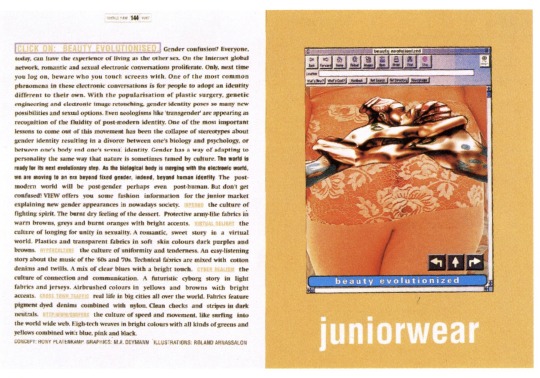
yoof magazine (1996-97)
2 notes
·
View notes
Photo


Yoof Magazine - Vol. 34 - Summer 1996 By Rony Platenkamp & Roland Arnassalon of M A Deymann
4 notes
·
View notes




